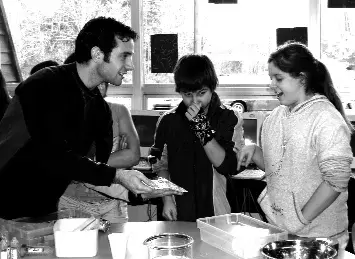Imagine classrooms full of children smiling, excited, jumping up, shouting, and being happy. Typically you might think this would happen for recess, candy, or maybe the school's annual Fun Fair, but this past week on January 11th and 12th, the students at Haa-huu-payuk school were really excited about science.
Through capacity building work being done by the Nuu-chah-nulth Tribal Council's fisheries program -now called Uu-a-thluk (pronounced ooh-ah-thluk, a Nuu-chah-nulth word meaning 'taking care of')-children and youth were identified as the future of resource management. Many children and youth, however, have a strong dislike of math and science, key subjects needed to advance into resource management careers.
"We've heard the message about building the capacity of youth from Ha'wiih, elected chiefs, teachers, and parents," says Shannon Cowan, Uu-a-thluk's Capacity Building Coordinator. "Getting these types of enrichment activities into the schools as early as we can is one step towards demystifying science and math and showing how useful and fun they can be."
While researching potential learning activities last fall, Shannon happened to notice that a program called 'Let's Talk Science' - a non-profit organization that brings UBC science graduate students together with elementary students to do exciting science demos and experiments - was coming to the island. She made a few phone calls to ensure that Haa-huu-payuk was one of the program's stops.
"It was brilliant," says grade 5/6 teacher Nicole Baribeau. "They asked me what we were doing in class and then brought along experiments that leant themselves really well to what we are doing… They made elephant paste...and used dry ice to bring about chemical reactions…the kids just loved it."
In a report prepared for NTC last year, science enrichment programs like UBC's "Let's Talk Science" were recommended for children in Nuu-chah-nulth communities who don't often have broad exposure to science. The programs use hands-on activities and fun technology to increase excitement and engagement about science.
"Ultimately our goal to is bring programs like Let's Talk Science to more remote Nuu-chah-nulth communities," says Shannon. "Haa-huu-payak fit in with Let's Talk Science schedule on short notice, so we were able to make that work. Now we're looking at other programs to bring science enrichment to communities that normally wouldn't have that experience."
In the case of Let's Talk Science, UBC graduate students Derrick Randall and Alfredo Franco travel with a SUV filled with all sorts of strange things from gummy bears and nitrous oxide, to disposable diapers and hydrogen peroxide, all in the name of science! This unusual combination of materials are set up for classes to teach exciting experiments such as changes in matter through chemical reactions, to genetics through an exercise with sorting gummy bears. The kids go wild!
"The hands-on experience of science is always highly motivating for young children," said Principal Darryl Ashdown. "The magic of it, the suspension of thinking really warms up children's curiosity and enthusiasm."
The two days of science at Haa-huu-payuk proved to be very successful and "a great lead-in" to a science fair that principal Ashdown is planning for the end of February. "Having a couple of young grad students who know their stuff and are excited about what they do made for great day," exclaimed principal Ashdown.
Submitted by Kelly Poirier, Uu-a-thluk Outreach Coordinator







